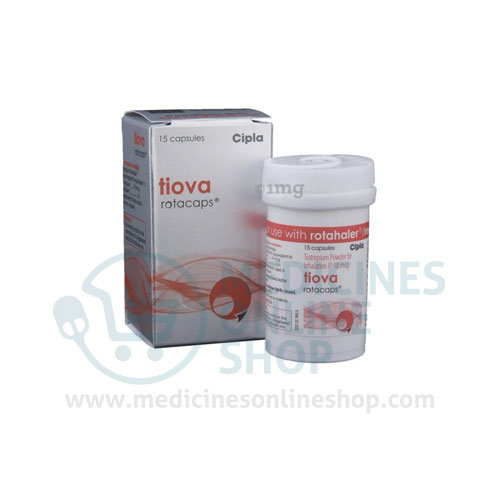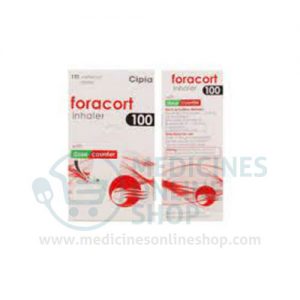Tiotropium Information
What is this drug used for?
• It is used to treat COPD (chronic obstructive pulmonary disease).
• It is used to treat asthma.
• This drug is not to be used to treat intense flare-ups of shortness of breath. Use a rescue inhaler. Talk with the doctor.
Possible side effects
Tiotropium may cause side effects. Tell your doctor if any of these symptoms are severe or do not go away:
• Dry mouth.
• Upset stomach.
• Nose or throat irritation.
• Runny or stuffy nose.
• Cough.
• Stomach pain.
• Dizziness.
Some side effects can be serious. If you experience any of these symptoms, call your doctor immediately or get emergency medical treatment:
• Signs of an allergic reaction, like rash; hives; itching; red, swollen, blistered, or peeling skin with or without fever; wheezing; tightness in the chest or throat; trouble breathing, swallowing, or talking; unusual hoarseness; or swelling of the mouth, face, lips, tongue, or throat.
• Change in eyesight, eye pain, or very bad eye irritation.
• Eye redness.
• Seeing halos or bright colors around lights.
• Trouble passing urine, pain when passing urine, passing urine in a weak stream or drips, or passing urine more often.
• Chest pain or pressure.
• This drug can cause very bad breathing problems right after you take a dose. Sometimes, this may be life-threatening. If you have trouble breathing, breathing that is worse, wheezing, or coughing after using this drug, use a rescue inhaler and get medical help right away.
Medication Safety Issues
Sound-alike/look-alike issues:
Spiriva may be confused with Apidra, Inspra, Serevent
Tiotropium may be confused with ipratropium
Storage and Stability
Spiriva HandiHaler: Store at 25°C (77°F); excursions permitted between 15°C and 30°C (59°F and 86°F). Avoid extreme temperatures and moisture. Do not store capsules in HandiHaler device. Store capsules in the blister pack and only remove immediately before use. Once protective foil is peeled back and/or removed, the capsule should be used immediately; if capsule is not used immediately it should be discarded.
Spiriva Respimat: Store at 25°C (77°F); excursions are permitted between 15°C and 30°C (59°F and 86°F). Avoid freezing.
Adverse Reactions
Non-postmarketing incidences listed are for powder for inhalation unless otherwise specified.
>10%:
Gastrointestinal: Xerostomia (powder and solution: 4% to 16%)
Respiratory: Upper respiratory tract infection (41% to 43%), pharyngitis (powder and solution: 7% to 16%), sinusitis (powder and solution: 3% to 11%)
1% to 10%:
Cardiovascular: Chest pain (powder and solution: ≤7%), edema (dependent, 3% to 5%), angina pectoris (1% to 3%; includes exacerbation of angina pectoris), palpitations (powder and solution: ≤3%), hypertension (solution: 1% to 2%)
Central nervous system: Headache (powder and solution: 4% to 6%), depression (≤4%), insomnia (powder and solution: ≤4%), paresthesia (1% to 3%), dizziness (powder and solution: ≤3%), voice disorder (powder and solution: ≤3%)
Dermatologic: Skin rash (powder and solution: 1% to 4%), pruritus (powder and solution: ≤3%)
Endocrine & metabolic: Hypercholesterolemia (1% to 3%), hyperglycemia (1% to 3%)
Gastrointestinal: Abdominal pain (5% to 6%), dyspepsia (1% to 6%), constipation (powder and solution: 1% to 5%), vomiting (1% to 4%), gastrointestinal disease (not otherwise specified; 1% to 3%), gastroesophageal reflux disease (powder and solution: ≤3%), oropharyngeal candidiasis (powder and solution: ≤3%), stomatitis (includes ulcerative stomatitis; powder and solution: ≤3%), diarrhea (solution: 1% to 2%)
Genitourinary: Urinary tract infection (powder and solution: 1% to 7%)
Hypersensitivity: Hypersensitivity reaction (powder and solution: ≤3%)
Infection: Candidiasis (3% to 4%), infection (1% to 4%), herpes zoster (powder and solution: ≤3%)
Neuromuscular & skeletal: Arthralgia (powder and solution: ≤4%), myalgia (4%), arthritis (≥3%), leg pain (1% to 3%), skeletal pain (1% to 3%)
Ophthalmic: Cataract (1% to 3%)
Respiratory: Rhinitis (powder and solution: ≤6%), epistaxis (powder and solution: ≤4%), cough (powder: ≥3%; solution: 1% to 2% ), flu-like symptoms (≥3%), bronchitis (solution: 3%), laryngitis (powder and solution: ≤3%), allergic rhinitis (solution: 1% to 2%)
Miscellaneous: Fever (solution: 1% to 2%)
<1%, postmarketing, and/or case reports: Abnormal hepatic function tests, anaphylaxis, angioedema, application site irritation (powder; includes glossitis, oral mucosa ulcer, pharyngolaryngeal pain), atrial fibrillation, blurred vision, bronchospasm, dehydration, dermal ulcer, dysphagia, dysuria, gingivitis, glaucoma, glossitis, hepatic insufficiency, hoarseness, increased intraocular pressure, intestinal obstruction (includes paralytic ileus), joint swelling, limb pain, muscle spasm, mydriasis (if powder comes in contact with eyes), oropharyngeal pain, paradoxical bronchospasm, skin infection, supraventricular tachycardia, tachycardia, throat irritation, tonsillitis, urinary retention, urticaria, xeroderma




